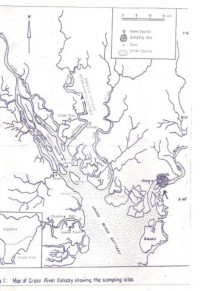Littoral <i>Microcrustacean</i> In Cross River Estuary, Nigeria: Ecological Assessment
Keywords:
Littoral, Microcrustaceans, Cross River Estuary, NigeriaAbstract
This study aimed at examining the abundance, composition and distribution of littoral microcrustacean in the three respective habitats of the Cross River Estuary. A total of 324 individual littoral microcrustaceans belonging to 56 species and 10 taxonomic groups were recorded in the course of the study. A one-way analysis of variance (ANOVA) revealed that there was no significant difference in the littoral microcrustacean abundance between the three stations. The number of individuals in stations 1 and 2 correlate very strongly with the sediment substrate whereas station 3 was negatively correlated with the sediment substrate. The relatively low habitat specificity of the littoral microcrustacean in the Cross River Estuary indicates that their broader use as bioindicators for various anthropogenic stressors should be investigated.
References
Akpan, E. R. (1994). Seasonal Variation in Phytoplankton Biomass in Relation to Physicochemical factors in Cross River Estuary of South Eastern Nigeria. Ph.D Thesis, University of Calabar.
Asuquo, F. E. (1998). Physicochemical Characteristics and Anthropogenic Pollution of the Surface Water of Calabar River, Nigeria. Global Journal of Pure and Applied Science, 5, 595-600.
Castro, P. and Huber, M. E. (2005). Marine Biology. New York: McGraw-Hill.
Dole-Oliver, M. J., Galassi, D. P. M., Marmomer, P. and Creuze des Chatellier, M. (2000). The Biology and Ecology of Lotic Crustaceans. Freshwater Biology, 44, 63-92
Enyenihi, U. K. (1991). The Cross River Basin: Soil characteristics, Geology, Climate, Hydrology and Pollution, 'International Workshop on Methodology and Quantitative Assessment of Pollution Load of Coastal Environment (FAO/ UNAP/IOC/WHO), 17pp
Ewa-Oboho, I. O. (2006). Ecological effects of channelization on a tropical marine ecosystem. Impacts on intertidal fish communities in the Cross River, Nigeria. West African Journal of Applied Ecology 9, 37-50.
Flossner, D. (2000). The Copepod and Cladocera. Leiden: Budchay Publishers.
Fryer, G. (1975). The Feeding Mechanisms of Some Freshwater Cyclopoid Copepods. Proceedings of the Zoological Society of London, 129, 1-5.
Imoobe, T. O. T. (2002). A Preliminary Checklist of the Macrobenthic fauna Offshore, Niger Delta, Nigeria. African Journal of Environmental Pollution and Health, 1 (2), 14-23.
Imoobe, T. O. T. (2003). Freshwater Ostracod from Jameieson River, Niger Delta Region, Nigeria. Journal of Aquatic Science, 18 (2), 133- 118.
Kororvchinsky, N. M. (1986). Invertebrate of the Littoral Zone of Lake Glubokoe. Hydrobiologia, 141, 83-86.
Lalli, C. M and Parsons, T. R. (1997). Biological Oceanography: An Introduction (2nd Ed.). Oxford: Butterworth-Heinemann,
Lowenberg, U. and Kunzel, T. (1991). Investigation on the Trawl Fishery of the Cross River Estuary, Nigeria. Journal of Applied Ichthyology, 7, 44-53
Moses, B. S. (1988). Growth mortality and potential yield of Bonga, Ethmalosa fimbriata (Bowdich 1825) of Nigerian Inshore waters. Fishery Research 6: 233-247.
Nawa, I. G. (1982). An ecological study of the Cross River Estuary. PhD Thesis, University of Kiel, F. R Germany 162pp.
Newell, G. E. and Newell, R. C. (1977). Marine Plankton: A Practical Guide (5th Ed.). London: Hutchinson and Co. (Publishers) Ltd.
Ogbeibu, A. E. (2005). Biostatistics: A Practical Approach to Research and Data Handling. Benin City: Mindex Publishing Company Limited.
Paterson, M. (1993). The Distribution of Microcrustacean in Littoral Zone of a Freshwater Lake. Hydrobiologia, 263, 173-183.
Pechenick, J. A. (1996). Biology of the Invertebrate. New York: McGraw-Hill
Prasad, S. N. (2000). Marine Biology. New Delhi: Campus Book International.
Simirnov, N. N. (1971). Chydoridae Fauna USSR, Crustacean 1 (2). Israel Program for Scientific Translation in Jerusalem, pp1974
Simon, D. R and Ramsay, P. M. (1997). Microcrustacean Communities in Streams of Two Physiologically Contrasting Region of Britain. Journal of Biogeography, 24, 101-111.
Tait, R. V. and Dipper, F. A. (1998). Element of Marine Ecology. Great Britain: Butterworth-Heinemann.
Waife, G. and Frid, C. L. J. (2001). Marine Zooplankton of West Africa. Dawin Initiative Report 5, Ref. 162/7/451. 120pp.
Walzeng, B., Yan, N. D., Parsons, T. W. and Skan, Paise, O. (2008). Acidity Versus Habitat Structure as Regulators of Littoral Microcrustacean Assemblages. Freshwater Biology, 53, 290-303.
Warwick, R. W. (1993). Environmental Impact Studies on Marine Communities: Pragmatic Consideration. Australian Journal of Ecology, 18, 63-80.

